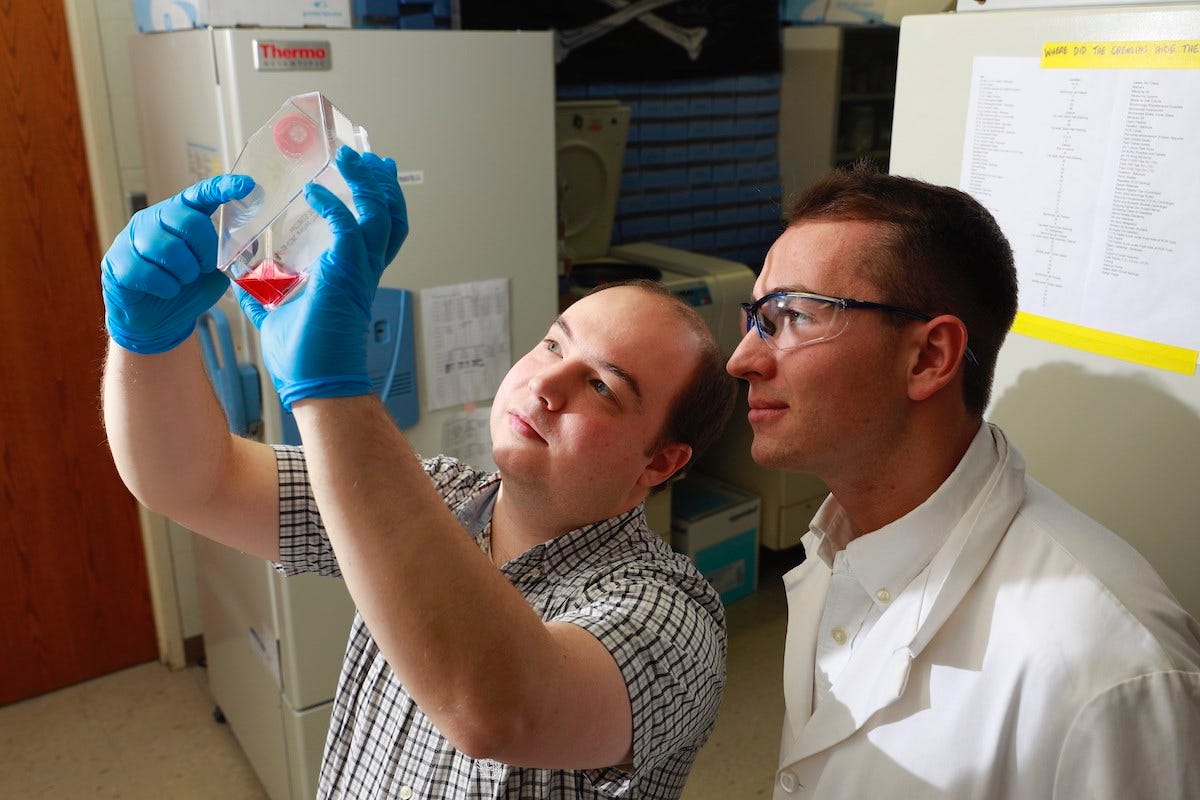Butler Lab Exposes a Way to Kill Coronavirus
 Dr. Stobart (left) says the team identified a protein that
Dr. Stobart (left) says the team identified a protein that
Subscriber Benefit
As a subscriber you can listen to articles at work, in the car, or while you work out. Subscribe NowThe rampant spread of coronavirus in China is a reminder of a frustrating limitation of modern science: researchers have yet to uncover how to kill viruses. What’s needed most is a target, and that’s exactly what a research team—comprised mostly of students—could uncover at Butler University. The team has discovered a target that may help drug makers crack the code to kill the coronavirus.
“[The coronavirus outbreak in China] is a somber, but exciting time,” says Butler Biology Assistant Professor Dr. Chris Stobart, who’s leading the research team. “It’s a weird moment for scientists to be in this position; as scientists, we’re intrigued and excited to see what this virus is going to do. We’re able to watch and witness how it’s adapting to humans, and it gives us new insight into what coronaviruses do in general. But on a more somber note, there are a lot of people who are becoming extremely sick or dying from these infections.”
Stobart says there are other coronaviruses that have infected humans, including SARS, which appeared in 2002, and MERS, which emerged in 2012. Currently, no drug exists to kill the coronavirus, so doctors treat it instead with supportive care, such as monitoring vitals and providing oxygen to help the body fight the virus.
Stobart says viruses, by nature, are replicating systems “that get inside us, and all they want to do is copy themselves.” The team’s work, which he’s confident will be published in the coming months, centers on an “unpackaging protein” for the coronavirus.
“When the virus enters a cell, it encodes all of its replication machinery in this really well-packaged, long protein structure,” says Stobart. “And the protein we’re looking at is involved in setting up that machinery.”
Benjamin Nick, a senior at Butler studying biology and chemistry, is one of five students leading the research. The team is focusing on what’s called the interdomain loop, which Nick likens to a strand of Christmas lights.
“Each light is like a part of the DNA of the virus. One bulb will go out, and it turns off the whole strand,” says Nick. “I’m trying to figure out which bulb is going to turn off the whole strand and result in the whole Christmas tree being knocked out. That’s the idea of the interdomain loop. [We want to] find the specific bulb, or the specific point, that’s going to knock everything else out.”
Stobart says the team has identified a region of the protein, called nsp5, that has previously been unexplored and could lead to a drug that kills the virus.
“We mutated parts of this region of this protein, and it prevented the virus from replicating,” says Stobart, “so it’s a key target for drug development and inhibitors. People who develop drugs can…have an idea of where to start the process of making drugs. Otherwise, they’re just searching blind and looking for random molecular targets. Now, they have a target.”
Stobart emphasizes that the discovery is a result of undergraduate research, which is a signature teaching method for science at Butler.
“This was 100% done by Butler undergrads—18 to 22 year-old students in a research lab for the first time in their lives,” says Stobart. “And they’re about to publish a scientific paper that could, down the road, lead to significant discovery—a new drug that could save people’s lives.”
Nick says it caught him by surprise that a seemingly “very minor thing” he’s analyzed for thousands of hours in a tiny basement lab, suddenly, became very relevant.
“That’s why the work that scientists and the infectious disease community do is important: it’s not a matter of ‘if,’ but a matter of when these [outbreaks] arise,” says Nick. “It’s easy to lose sight of the benefit or impact you can have on the world around you. So many labs at universities across the country focus on one specific component of one specific species, but the broader implications of a simple finding are so profound.”
While the coronavirus outbreak in China is dominating headlines, Stobart notes that the target the team has discovered could be consistent among other coronavirus strains.
“[The China outbreak] is a great reminder that what we’re doing can have direct, real-world applications,” says Stobart. “What we’re discovering in a lab here at Butler—with strictly undergraduate, student-driven research—can, in theory, translate directly to treatment that can save people’s lives.”
Stobart says undergraduate research is a critical part of the science program at Butler.
Stobart explains how the team’s lab work could open the door to a drug that would kill coronavirus.
Aside from scientific lessons learned in the lab, Nick says he’s also discovered that “persistence is key.”
